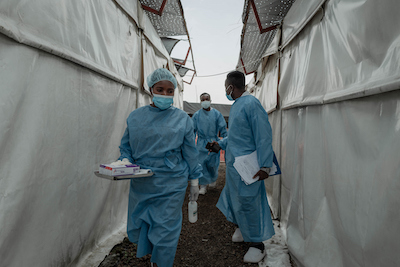Este artículo estará disponible en español en El Tiempo Latino.
In 2022, mpox — a disease caused by the monkeypox virus, which is found in small mammals and has been known to infect people in parts of Africa for decades — burst into greater international awareness. The virus, which causes a painful rash and can be deadly, spread around the world, primarily among men who have sex with men. In response, the World Health Organization and the U.S. government declared public health emergencies.
Mpox cases outside Africa subsequently decreased, and the public health emergencies were declared over in 2023. The global outbreak is still ongoing, but case numbers have fallen significantly. In the U.S., for example, the number of people diagnosed with mpox is down from a high of 11,000 cases per month in the summer of 2022 to 250 cases per month now, according to the Centers for Disease Control and Prevention.

However, the situation in Africa in recent years has noticeably worsened. On Aug. 14, the WHO once again declared an mpox public health emergency of international concern. A day earlier, the Africa Centres for Disease Control and Prevention had declared a public health emergency of continental security.
Especially in the Democratic Republic of Congo, mpox cases are surging — this time primarily from two other types of the virus. As of late August, there have been more than 20,000 mpox cases and more than 600 deaths reported in Africa in 2024, although not all are confirmed cases, given a dearth of access to testing. This compares with around 15,000 reported cases in 2023.
One type of the virus has now spread to countries in Africa where mpox has not been historically reported. Sweden and Thailand have also each reported one imported case.
The WHO declared the public health emergency in recognition of the extraordinary nature of the current outbreaks, the international spread of mpox and the need for a coordinated international response.
The hope is that the international public health emergency will galvanize the kind of global cooperation and resource-sharing needed to control the outbreaks in Africa. “What’s being done right now on the ground to try and contain this virus, certainly in DRC, is falling onto the backs of our Congolese colleagues who are the experts in the world at mpox,” Jason Kindrachuk, who studies the circulation and transmission of emerging animal-derived viruses at the University of Manitoba, told us, referring to the Democratic Republic of Congo, also known as simply Congo. “If we give them the support, they will be able to get this contained.”
We spoke with experts about the current increase in mpox cases, the international public health emergency and what this means for people in Africa and globally.
Where are the various mpox outbreaks?
There are three different outbreaks of mpox: two centered in Congo and the ongoing global outbreak that was recognized in 2022.
One of the Congolese outbreaks is occurring in western and central parts of the country, primarily among children, and is thought to be spreading the way mpox historically has spread — via contact with infected animals, followed by limited subsequent spread to other people through close contact. There are also cases in some other nearby countries where mpox is traditionally found.
The other outbreak is in eastern Congo, where mpox is not typically reported. This outbreak is spreading among adults, including among sex workers, as well as affecting children in a refugee camp. This outbreak has spread to four nearby nations — Uganda, Kenya, Rwanda and Burundi — and led to at least two other cases outside of Africa.
How else are the mpox outbreaks different?
Of the two major types, or clades, of monkeypox virus, both Congolese outbreaks are due to clade I, whereas the global outbreak is due to clade II.
The two clades have sporadically infected people for decades, but in different parts of Africa. Clade I cases have typically occurred in central Africa, with higher reported mortality rates, while clade II cases have largely occurred in West Africa.
As we’ve written, traditionally, monkeypox has primarily been transmitted to humans from animals such as rodents and other small mammals when people consume or prepare undercooked bushmeat, or when they are bitten, scratched or otherwise have close contact with live animals. Subsequent spread between people can occur, but is usually limited, because it requires close contact between people or with infected materials.
In 2022, however, the virus showed more sustained transmission between humans, spreading to previously unaffected areas around the world, often within sexual networks of men who have sex with men.
Genetic sequencing of the viruses involved in that outbreak, which remains ongoing and is now recognized to have begun in Nigeria as early as 2014, showed that they belonged to a subset of clade II viruses, which scientists now refer to as clade IIb.
Following this development, researchers wondered if clade I monkeypox virus similarly had the potential to show sustained spread via dense sexual networks, and they started to monitor for such cases, Kindrachuk, the University of Manitoba scientist, said.
By fall 2023, scientists including Kindrachuk were tracking an outbreak of mpox in previously largely unaffected areas in eastern Congo.
The scientists showed that the virus spread via sexual contact involving both men and women in a mining region, with many sex workers affected. The newly described viruses, linked to “more sustained human-to-human transmission,” appear to have started spreading between people around September 2023 and were assigned to a new subclade, clade 1b, he said.
The majority of mpox cases in Congo, however, continue to be among children in the west and central areas. These clade I infections — now called clade 1a infections — have been increasing for many years, driving the “very dramatic increase” in cases between 2022 and 2023 and a still further increase this year, Kindrachuk said.
Why did the WHO declare a public health emergency?
The WHO declaration of a public health emergency of international concern stemmed from multiple mpox outbreaks occurring simultaneously, Dr. Krutika Kuppalli, an infectious disease physician who works on emerging diseases, told us. Kuppalli formerly worked for the WHO on its mpox team.
 Health care workers at an mpox treatment center near Goma, Congo, on Aug. 17, 2024. Photo by Guerchom Ndebo / AFP via Getty Images.
Health care workers at an mpox treatment center near Goma, Congo, on Aug. 17, 2024. Photo by Guerchom Ndebo / AFP via Getty Images.
Clade Ib mpox has continued to spread in previously largely unaffected, eastern regions of Congo. This spread is linked to sexual contact among both men and women, Kindrachuk said, but also via close contact, such as suspected transmission between children and within households, as well as spread in a refugee camp in Goma. “It’s not just an STI,” he said, referring to a sexually transmitted infection.
As of early September, clade Ib mpox also has been identified in four other African countries and in two travelers arriving in Thailand and Sweden from affected countries.
Kindrachuk expressed particular concern about the spread of the clade 1b virus in Burundi, where there have been more than 700 reported cases as of late August, most occurring in children. Burundi has “extremely” limited resources for health care and response to the outbreak, he said.
For an international public health emergency to be declared, Kuppalli said, there must be an “extraordinary” event. The emergence of clade Ib viruses with sustained human-to-human transmission was considered extraordinary and is one factor behind the international public health emergency declaration. The international spread of clade 1b virus also contributed to the declaration.
However, in parallel with the clade 1b outbreak, there has been an “exponential” increase in clade 1a mpox in Congo, Kuppalli said, for reasons that are unclear.
“It’s not as simple … as they declared the [international public health emergency] because of clade 1b,” Kuppalli said. “That was part of it, but it was not the whole reason.” The uptick in cases, “which is mostly due to clade Ia,” was also part of the reason, she said.
The final factor required for an international public health emergency is a need for international collaboration, Kuppalli said. After the 2022-2023 emergency was declared over, the WHO emergency committee said that the outbreak was not over and encouraged the global community to keep providing resources and support, “particularly to Africa,” she said. “That didn’t happen.”
“The public health emergency in my mind was really trying to match the current situation in DRC, the escalation of what has been happening there, the lack of vaccines, lack of therapeutics, certainly lack of diagnostic capacity, as well as that movement out of the country into additional locations,” Kindrachuk said.
How can people prevent and treat mpox?
There are vaccines available for mpox, and in the U.S., there is no shortage of vaccines for eligible people. (Americans are recommended to get mpox vaccines if they have certain sexual risk factors and are gay or bisexual men, men who have sex with men, or are transgender or gender nonconforming, or if they have intimate contact with someone meeting one of those descriptions or someone who may have mpox.)
This is in contrast to the situation in Congo and other African countries, where vaccines have been “nonexistent,” Kindrachuk said.
A public health emergency of international concern is the WHO’s highest level of alert and comes with recommendations for countries on how to respond, obligations for international cooperation, release of WHO funds and appeals for funding.
Scientists hope the international public health emergency will spur the action needed to control the outbreaks. “We’ve seen vaccine deployment discussions go from potentially being deployment in months to now deployment within weeks or a week,” Kindrachuk said of the effect of the international public health emergency so far. The first vaccine donations arrived in Nigeria Aug. 27 and in Congo Sept. 5.
“It’s never going to be fast enough, it hasn’t been fast enough, but things are moving,” Kindrachuk said.
Vaccines are one important tool, Kuppalli and Kindrachuk both said, but there also needs to be more research to understand basic information on mpox, as well as more access to diagnostics. Another key piece of the response is communication to people in various communities.
And there needs to be better access to good clinical care for mpox. A clinical trial recently found that an antiviral used during the clade II outbreak, called Tpoxx, is not effective against clade I mpox. But the trial inadvertently revealed how effective good supportive care can be.
Kuppalli explained that participants in the trial hospitalized for clade I mpox died at much lower rates than is typical in Congo – 1.7% versus 3.6% or higher — and that this was simply because they got good supportive care. This includes things like “IV fluids, optimal pain management, wound care for the lesions to prevent them from getting infected” and managing complications such as eye problems, brain inflammation or scarring of the skin, she said.
Why is clade I mpox on the rise now?
It is unclear why there has been such a dramatic rise in clade I mpox cases in Congo, largely driven so far by clade Ia cases.
Kuppalli said that one possible explanation for the increased cases could be changes in ecology. Shifts related to climate change or urbanization could be changing the geographic range of animal species that carry the virus or the amount of contact people have with the animals, Kindrachuk further explained.
Researchers also have suggested that human population growth, the spread of farming further into forested land or diminishing numbers of large animals available to hunt could have changed humans’ level of contact with small rodent species, leading to mpox cases.
Another question is whether there is “a piece of this that is just related to increased capacity for surveillance as well as increased community knowledge,” Kindrachuk said. The recent dramatic increase in cases came after the 2022 outbreak, which gave people access to more information on mpox, he said.
There could also be some change affecting the mostly younger people who get clade Ia mpox, such as an increase in malnourishment or an increase in another infectious disease like measles, Kuppalli said. These factors could make children more susceptible to mpox.
Another factor is smallpox. Mpox is related to the more severe disease, so previous exposure to smallpox or smallpox vaccination protects against mpox. But because smallpox was declared eradicated in 1980, people in younger generations have never gotten smallpox or been vaccinated against it. Scientists believe that mpox is infecting more people as smallpox immunity in the population wanes.
How severe is clade I mpox?
Experts urged caution in interpreting data on mpox severity.
“Historically, clade I was associated with more severe disease” than clade II, Kindrachuk said, but “there’s a lot of context and nuance that needs to be included.”
Case fatality rates for a virus are simply a measure of how many reported cases are fatal. This can be an indicator of the virus’s fundamental lethality, but the case fatality rate also depends on whether mild cases are reported and the context in which cases are occurring.
For instance, in Congo, there is limited access to testing, and mild cases may go unreported, Kindrachuk said. “The true lethality for the broader population, including high-income countries and low-income countries, we don’t fully understand,” he said.
Kindrachuk added that some data indicate that clade 1a virus has a higher case fatality rate than clade 1b virus. But whether clade 1a is really more lethal remains unknown. Given that more clade 1a cases are in children, and the disease tends to be more dangerous for children, he said, a higher case fatality rate is not surprising.
Does clade I mpox pose a global threat?
There is a possibility that clade I mpox will spread more broadly, particularly if the outbreaks in Africa remain uncontrolled.
“When we talk about the global north, I think the risk continues to be very, very low,” Kindrachuk said. “We’ve had mpox still circulating for the last two years,” he continued, referring to the limited clade II mpox cases that continue to be diagnosed globally. “We haven’t seen the movement out into children or into schools or into broader communities.”
Currently, the U.S. CDC considers the risk of clade I virus to the general U.S. population to be low. The agency says the risk to “U.S. men who have sex with men with more than one sexual partner, and their partners” is low to moderate.
A prior international emergency — the COVID-19 pandemic — looms large in people’s memories. But there are many differences between mpox and COVID-19.
For one thing, COVID-19 is a respiratory virus that spreads through the air, whereas mpox spreads via close physical contact and does not readily transmit via the air.
The virus that causes COVID-19 “was transmitting very rapidly through respiratory transmission and through shared air spaces, and that was having very rapid effects in expansion across the globe, extremely, extremely quickly,” Kindrachuk said. “Monkeypox virus, all through the 54 years we have been studying that, has had that opportunity to move globally in the same way and hasn’t.”
In 2022, scientists saw the ability of the monkeypox virus to change and expand, Kindrachuk said, but the public health community was able to respond through measures such as vaccines and increased testing capacity and health care knowledge.
And the world is now in a “very different place” when it comes to the ability to spot mpox cases globally, he said, as indicated by the rapid detection of isolated cases of clade Ib mpox in travelers in Sweden and Thailand, rather than a delayed discovery of broader spread. There are also existing vaccine programs. Those factors “are working certainly in favor at keeping the virus suppressed from moving out to a much larger global pandemic situation, but that’s a very different situation than what we see in Africa right now,” he said.
“This is an outbreak that can be controlled if we quickly scale up and focus on the countries that are affected,” Kuppalli said.
Editor’s note: FactCheck.org does not accept advertising. We rely on grants and individual donations from people like you. Please consider a donation. Credit card donations may be made through our “Donate” page. If you prefer to give by check, send to: FactCheck.org, Annenberg Public Policy Center, 202 S. 36th St., Philadelphia, PA 19104.










